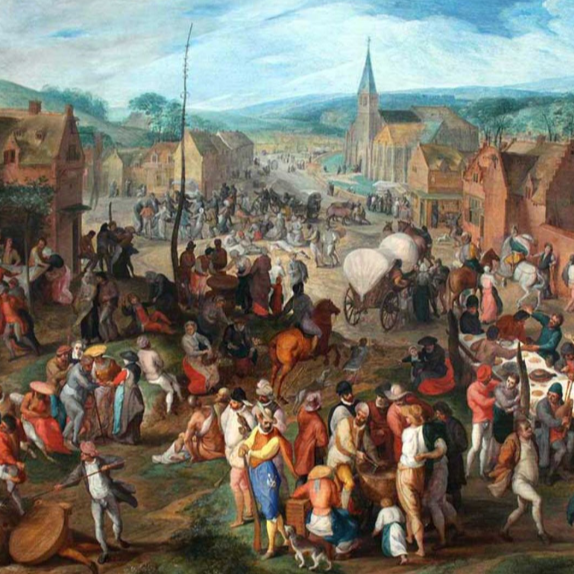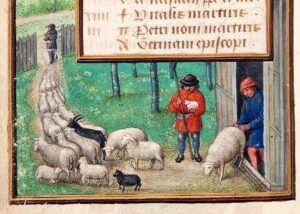- Regular Price
- £19.99
- Sale Price
- £19.99
- Regular Price
- £19.99
- Unit Price
- per

“I’m awoken by the morning light peeking through the wooden shutters. My only timekeeper is the local priest, but he has assured me today is 3rd July – seventeen years into the reign of Edward II. After packing my bag with food and coin, I set off on the three-day journey with my two sons. The bad weather slows us down, but we reach Hamptunscire by the end of the third day. The following morning, we arrive at the De La Woe (The Weyhill Fair). There are sheep and lamb as far as the eye can see. I have plenty of choice. Soon, I find a flock for sale with shiny coats and large frames. We settle on a good price on thirty heads. Now for the hard part: transporting them back home.” Anon.
Luckily I’m not a Woolman in the fourteenth century, otherwise that arduous process would have been the only way for me to fill the warehouse. Today, although we at the Wool Company are focused on sourcing finished woolen products rather than live sheep, there are a number of ways available to help us to do this; by using the internet to find potential new suppliers, by receiving new product details from our excellent manufacturers, by visiting trade fairs both in the UK and overseas (which, it has to be said are a lot less tedious to attend than the fourteenth century sheep fairs!).
We now live and work in a world where thanks to modern communications it is relatively easy to source our products using any of the methods above. However, these methods are all relatively new and have improved as the world of commerce and communications has developed in the last hundred years or so, with the biggest game changer being the internet only coming into play in the last twenty five years.
The Medieval Trade Show
Returning to our fourteenth century woolman, he of course had no such luxuries to help in the buying of his products, which is why the sheep fairs were so important to him on a personal level as well as to the wider economy.
The concept of Fairs began to grow with at the time when William the Conqueror became King. From the eleventh century, Fairgrounds popped up across the country, usually situated at the crossroads of ancient trackways, which enabled farmers and other merchants to meet up and trade their livestock or produce. Flocks of sheep would be driven to market often from many miles away.

A flock being driven to the fair.
Photo © Abbey Cwmhir Heritage Trust
As with most aspects of medieval life, the church was heavily involved (the word fair comes from the Latin ‘feria’ meaning holy day), with a church service being held at the start of each fair. No doubt they saw the event as another good way to make money… The Church benefitted from the medieval wool trade in more ways than one, including the construction of Wool Churches.
Each fair would last for a number of days, sometimes even weeks, often taking place in late summer or early autumn, before the harvest. This timing allowed farmers to attend the fairs after completing their agricultural tasks in the fields. It also provided an opportunity for transactions before the onset of winter. It is recorded that the fair for lambs at the Weyhill Fair, visited by our fourteenth century Woolman, took place in July.
The Predecessor to Glastonbury
As wool became a major trading commodity in the middle ages – even argued by some historians to be the backbone of the economy duing this period - the sheep fairs grew in importance with over 100,000 sheep sometimes traded in one day.

Ready to be sold: sheep in a pen depicted in a 14th century manuscript.
Photo © English Heritage
As the fairs continued to expand, they evolved beyond simple trading centres into huge social events. Dancers, musicians, singers, and other entertainers came from all over to take advantage of the crowds. Agricultural shows and competitions were commonly organized as part of sheep fairs. Farmers would showcase their best sheep, and judges would evaluate the animals based on criteria such as size, quality of wool, and overall health. Gambling became commonplace, with fair-goers betting on cock and dog fighting. It sounds like a Medieval take on Glastonbury!
Whilst sheep fairs were a key feature in society for hundreds of years, they declined from the 17th century as the English economy’s reliance on wool reduced. So, although improved technology and communications has made daily life for businesses today somewhat easier than it was for our fourteenth century counterparts, the underlying basic principles of buying quality products have hardly changed over the centuries.
Further Reading:
https://www.hampshire-history.com/weyhill-fair/
https://www.british-history.ac.uk/vch/hants/vol5/pp36-44
https://deepingsheritage.wordpress.com/2018/04/05/history-of-stamford-fairs-and-markets/
https://hungerfordvirtualmuseum.co.uk/?view=article&id=718&catid=10
2 comments
I love your products… and loved too reading this superior blog on the wool trade and sheep fairs… just great… well done 💛
I love your blogs. The poor sheep must’ve had such sore feet.